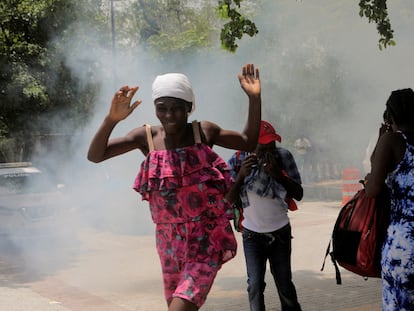The unanswered questions about the death of Mexican Maria Fernanda Sanchez in Berlin
The 24-year-old had been missing for two weeks. German police say that “no third party blame can be assumed” for the death, but the circumstances have not yet been clarified


Maria Fernanda Sanchez’s family and friends, along with dozens of volunteers dressed in white, gathered in Berlin on Saturday to ask for the 24-year-old student. A few hours later, German police announced that a body had been found in a canal in the capital. The family later confirmed that it corresponded to the young Mexican woman. In a brief statement, the Berlin police said about the death of the young woman: “According to the current findings, there is no evidence of third party culpability”. However, the circumstances have not yet been clarified. The discovery puts an end to two weeks of an intense search, in which 500 people have participated and more than 3,000 kilometers have been searched, but still leaves unresolved questions.
The disappearance of Maffy, as her friends called her, shocked the Mexican community in Europe. It had only been five months since Sanchez had arrived in Berlin, after graduating from the Tecnológico de Monterrey with a degree in Communication. After living in Querétaro, in central Mexico, the young woman was going to study for a master’s degree specializing in new media design at the University of Applied Sciences in Europe. A lover of yoga and music, her friends have remembered her all these days as a very cheerful and positive young woman, with many plans. Her parents noted that she was preparing for an upcoming trip to Spain.
From what has it is known so far, last Saturday, July 22, Sanchez was going to go to the big LGTB+ party in Berlin, the Christopher Street Day. However, the young woman finally decided not to attend in order to work on a university project. Shortly before noon, the student left her room in the student residence, located in the Treptow-Köpenick district on the outskirts of the capital, without anyone noticing her departure and left her cell phone on the bed.
The next day, her family was already alarmed by her absence. They used to have a phone call with Maffy every Sunday and she did not answer. Javier Sanchez, father of the Queretaro girl, said in an interview that the young woman lived on a first floor, whose balcony overlooks the street, and the door was open. In addition, people close to her told EL PAÍS that her room on Büchnerweg had been altered when the authorities arrived.
On Monday, Javier Sanchez and his wife Carolina Castañeda flew to Berlin. In those first days, Maffy’s friends organized to create an Instagram account (Find Maffy Berlin), which already has more than 24,000 followers, and search brigades to locate her. Photos of a smiling Maria Fernanda Sanchez went viral and search cards with basic information were translated into nearly 20 languages: she was 153 centimeters tall, had long brown hair, had tattoos on her arms, wore a yellow T-shirt and polka-dot pants on the day she disappeared.
It was only two days ago that Interpol had launched a search for the missing person. In addition to the 125 volunteer brigades, which had filled Berlin with search posters, the German police had used sniffer dogs and divers for canals, rivers and lakes. One of the canals the authorities claimed to have scoured is the Teltow canal in the Adlershof district, where this Saturday at 4 p.m. German time a passerby found Sanchez’s body near a bridge.
From the beginning of the search, the Berlin police pointed to a possible motive: “There are indications that the 24-year-old is under the influence of an exceptional psychological situation”. However, her family still wondered what the European authorities meant with that message. “What she told us was that she was very homesick,” her father Javier Sanchez told this newspaper last Thursday. The results of the autopsy are still pending.
Last July 14, Maria Fernanda Sanchez asked in a Facebook group called Latinas en Alemania if anyone knew a psychologist who spoke Spanish, because she was going through a “difficult time”. Maffy’s case has highlighted a pending issue for Mexican authorities in Europe: mental health care. Adaptation to different cultural codes, discrimination, lack of networks and lack of security in many cases can take their toll on young people trying to start a new life outside Mexico.
The embassy in Germany has reminded us these days that it has a free mental health serv9ce. “The normal thing is from time to time to get overwhelmed and feel bad. The responsible thing to do is to take time out and see specialists. The sooner the better. For ourselves and for our loved ones. We are just a phone call away: +49170 975 7763″, wrote Ambassador Francisco Quiroga. In the same vein, the Mexican Foreign Ministry has developed tools such as EscuchaMex, a free psychological support platform for Mexican citizens residing in France and Monaco.
“Laughing until it hurts, listening to the rain fall, having a nice dream, getting a hug”, says Maffy in a video shared by his friends, just before he starts singing: “It’s really so little that I need, I’ve never been fond of material things, don’t be surprised when I explain that I have a different kind of ambition, but don’t believe me, I’ll show you with the following example: I just need two sticks to mark the key, someone to inspire me and a little voice”.
Sign up for our weekly newsletter to get more English-language news coverage from EL PAÍS USA Edition









































